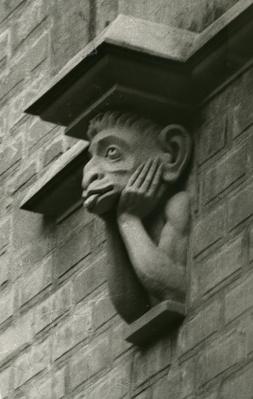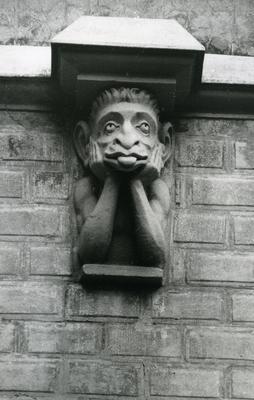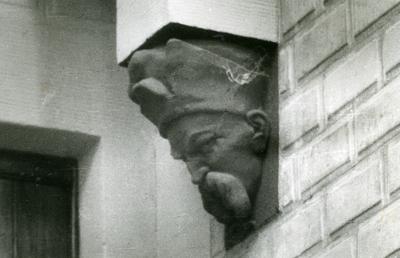Vul. Halytskoyi Armiyi, 5 – residential building (villa) ID: 2392
This two-storied house was built in 1903-1904 under a project designed by architect Artur Schleyen as a private villa of Antoni Stefanowicz, a renowned artist. The architecture of the villa combines contemporary designs with Neo-Gothic décor. It is an architectural monument (protection number 1227).
Story
Boczna Kadecka (now Hlinky) street, which was laid in the early 19th c., was at one time considered one of the most prestigious streets in the city. Located in a beautiful green area on the northern slopes of the Vuletski hills, it was in the first half of the 20th c. that it was built up with villas, Neo-Gothic at first (houses 1a, 5, 7), and Functionalist-style ones later, in the 1930s.
In 1913 the street was named in honor of
the Polish magnate family of Herburt. During the German occupation in 1943-1944
it was called Maienѕtraѕѕe, and in 1945 it was named
after Mikhail Glinka (1804-1857), a Russian composer (Melnyk, 2008, 173). In 2022, it was renamed into vul. Halytskoyi Armii (Galician Army street).
The projects of the three Neo-Gothic villas were designed by architect Artur Schleyen, including the villa number 5 owned by artist Antoni Stefanowicz. At that time this villa’s address was Boczna Kadecka 4 or conscription number 1601 ¼. The project of the villa was approved by the Lviv Magistrate on 26 November 1903; its construction was completed on 24 September of the following year (DALO 2/1/2261).
Probably, after the death of Stefanowicz in 1929 the villa became owned by Kazimierz Bartel and Maria Bartlowa, well-known Polish politicians. They appear as homeowners in documents from 1935: in that year architect Andrzej Frydecki was commissioned by the owner to design a project of the villa rearrangement (DALO 2/1/2261).
Today the house is used for dwelling purposes, it is divided into apartments.
Architecture
The villa is located separately amidst residential houses dating back to the late 19th - early 20th c., to the south of the city center. Its west façade overlooks Hlinky street. The plot is encircled by a fence, which serves as a retaining wall due to an elevation drop between the street and the plot.
As regards the plot configuration, it had a rectangular shape, which is indicated in the design drawings. There is an elevation drop between the plot territory and the street. The villa is located separately closer to the street. A recreation area near the villa is divided by paths, there is also a doorgarden and a utility zone there.
According to the 1903 design drawing, one could enter the villa’s ground floor rectangular lobby, where a staircase was arranged, with the following premises grouped around: a pantry, a kitchen, from where a toilet and a bathroom could be entered, as well as a dining room, a living room, and a study. There was a door leading to the garden in the kitchen, on the north side. The staircase connected the basement, the ground floor and the second floor. There were bedrooms, a toilet, a bathroom, and terraces on the second floor. In the second floor hall, there are also stairs leading to the attic. In the basement, there were the caretaker’s room, a laundry and an ironing room, a toilet and cellars.
In 1935 the villa’s interior layout was somewhat supplemented and changed as a vestibule was separated in the hall, an entrance to the toilet and bathroom was arranged from the corridor, and a door out to the garden was made from an additional vestibule. On the second floor, a bedroom and an ironing room were arranged after a large room was divided. In the basement, an additional entrance to the villa was arranged from the hall with the staircase, and a kitchen for the caretaker was made in one of the cellars.
According to the design drawings, the bridging between the floors consists of Klein vaults while the beams were made of reinforced concrete with the use of the then up-to-date Hennebique system (DALO 2/1/2261). The roof structure is made of wooden rafters.
Due to an elevation drop the villa has different heights. The building’s architectural composition is characterized by a dynamic and asymmetric combination of the two-storied volumes.
The two-storied villa with a terrace on its south-west façade is rectangular in plan. On its façades one can see open stonework and plastered surfaces based on lime-sand mortar, metal lattices of the windows, balcony fencing, and stairs railing. The villa can be entered via stairs through a semicircular portal, supported by a stylized Gothic column on one side and an impost shaped as a male moustached head in a high hat on the other side. The ground floor windows are segmental, rectangular, and semicircular; the second floor windows are rectangular and semicircular biforia and rectangular triforia having Gothic plastered trimming. The staircase windows (the north façade) have retained the original glass panes.
On the main (west) façade’s second floor level, there is a semicircular niche, with underneath a sculpture of a chimera, a creature with big ears and a stuck-out tongue, which supports its head with its hands. The stepped gable has a stylized Gothic top and roof windows in the shape of a semicircular triforium. The corner of the south and west façades is accentuated by a stylized buttress supporting a water sprout arranged there to drain water from the second floor terrace. The villa has gable and pyramidal roofs whose overhangs are supported by a profiled cornice.
The stylistic design of the façades is characterized by the use of decorative stylized Neo-Gothic elements, including a gable, a buttress, typical profiles and shapes of windows, doors, cornices, and a balustrade, as well as the presence of a water sprout, a column with a capital, a chimera sculpture, stained glass windows, the front door metal hinges, window and lantern lattices.
People
Artur Schleyen — a Lviv-based architect of Jewish descent, a public figure. In 1903 he designed the villa for the family of Antoni StefanowiczAntoni Stefanowicz — a Lviv artist from a Catholic Armenian family, who was the commisioner and the first owner of the villa
Andrzej Frydecki — an architect, teacher, and specialist in architecture of theaters. In 1935 he designed a project for the villa's reconstruction
Sources
- State Archive of Lviv Oblast (DALO) 2/1/2261.
- Світлана Лінда, "Архітектура історизму", Архітектура Львова: Час і стилі ХІІІ–ХХІ ст., ред. Ю. Бірюльов (Львів, Центр Європи, 2008), 410.
- Мельник Ігор, "Вулька і Помірки", Львівський Новий Світ та південні околиці Королівського столичного міста Галичини від Святого Юра до Наварії (Львів, Центр Європи, 2008), 173.










